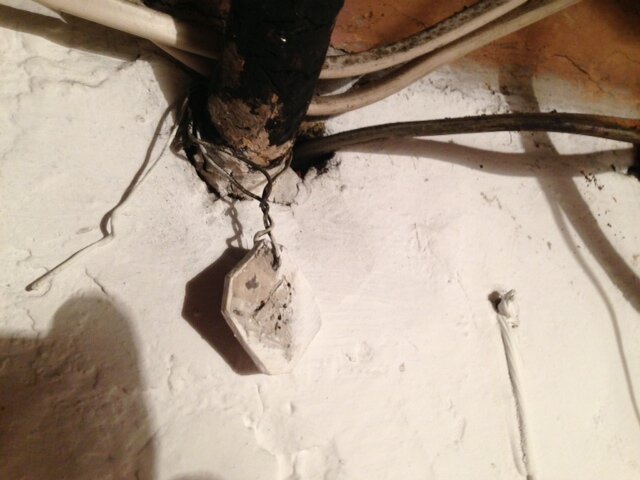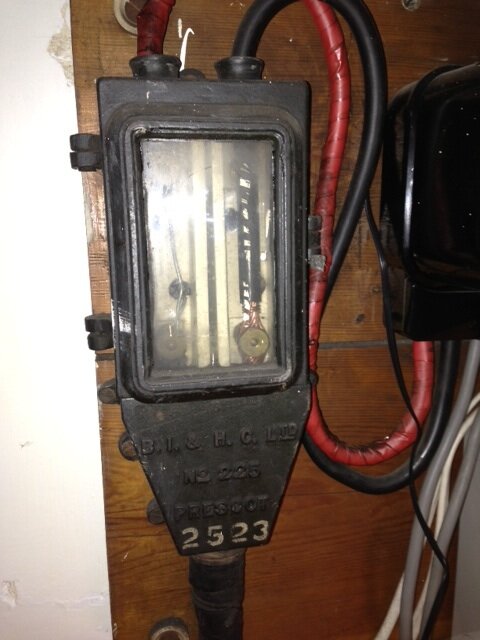S
Svenedin
Hello,
I have just joined the forum. I'm not an electrician (I'm a doctor) so please forgive me if my terminology is not correct. I'm starting this thread as I thought it might be of historical interest to some members. Unfortunately I'm not allowed to post pictures yet.
I am going to have some electrical work done at my house and I had an electrician round for a quote yesterday. He had a look at the consumer board and noticed the supply cable coming into the cellar and the ancient main fuse (before the meter). He said that in 30 years of working locally (Croydon, Surrey) he had never seen anything so old. He said I should get on to the supply company and ask for an inspection. I phoned the company and they agreed that they would send an engineer round. The engineer arrived this morning (Sunday). He also said he had never seen anything so old and waxed lyrical about the cast iron head on the supply cable saying they would want it for their museum. Although he assured me it is perfectly safe he said they would replace it tomorrow!
Anyhow, the article in question is a cast iron head on the original supply cable. It is stamped "B I and H C Limited Prescot No. 225" and has the number "2523" in white paint. It also has a lead seal with "B" stamped on it. There is a glass window through which the live and neutral can be seen. The neutral is a thick stranded cable and the live is fuse wire (?100 amp). The cable is thick, bitumen insulated and armoured.
I have discovered that BI and HC is British Insulated and Helsby Cable Limited, Prescot is a town in Lancashire where the factory was. The engineer told me that the lead seal with B on it means blue phase. Presumably 2523 in white paint is the serial number.
Has anyone seen these before (I can't believe they are that unusual)? Does anyone know the approximate date? We think maybe 1910. The house was built in 1902 and was gas lit so it could either have had both gas and electricity at the same time or perhaps the electricity came a little later. I also wonder who might be interested in pictures of this. I expect some people have an interest as there seem to be collectors of almost anything.
Also what does "blue phase" mean? I understand that early electrical supply was not standardised in voltage or frequency. As the house would have been single phase does this mean one of the phases of 3 phase?
Thank you in advance for helping me with my research. we've lived here 34 years and the house still surprises me from time to time.....
Best Wishes,
Stephen
I have just joined the forum. I'm not an electrician (I'm a doctor) so please forgive me if my terminology is not correct. I'm starting this thread as I thought it might be of historical interest to some members. Unfortunately I'm not allowed to post pictures yet.
I am going to have some electrical work done at my house and I had an electrician round for a quote yesterday. He had a look at the consumer board and noticed the supply cable coming into the cellar and the ancient main fuse (before the meter). He said that in 30 years of working locally (Croydon, Surrey) he had never seen anything so old. He said I should get on to the supply company and ask for an inspection. I phoned the company and they agreed that they would send an engineer round. The engineer arrived this morning (Sunday). He also said he had never seen anything so old and waxed lyrical about the cast iron head on the supply cable saying they would want it for their museum. Although he assured me it is perfectly safe he said they would replace it tomorrow!
Anyhow, the article in question is a cast iron head on the original supply cable. It is stamped "B I and H C Limited Prescot No. 225" and has the number "2523" in white paint. It also has a lead seal with "B" stamped on it. There is a glass window through which the live and neutral can be seen. The neutral is a thick stranded cable and the live is fuse wire (?100 amp). The cable is thick, bitumen insulated and armoured.
I have discovered that BI and HC is British Insulated and Helsby Cable Limited, Prescot is a town in Lancashire where the factory was. The engineer told me that the lead seal with B on it means blue phase. Presumably 2523 in white paint is the serial number.
Has anyone seen these before (I can't believe they are that unusual)? Does anyone know the approximate date? We think maybe 1910. The house was built in 1902 and was gas lit so it could either have had both gas and electricity at the same time or perhaps the electricity came a little later. I also wonder who might be interested in pictures of this. I expect some people have an interest as there seem to be collectors of almost anything.
Also what does "blue phase" mean? I understand that early electrical supply was not standardised in voltage or frequency. As the house would have been single phase does this mean one of the phases of 3 phase?
Thank you in advance for helping me with my research. we've lived here 34 years and the house still surprises me from time to time.....
Best Wishes,
Stephen








 )
)






